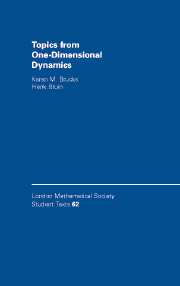Book contents
- Frontmatter
- Contents
- List of Figures
- Preface
- 1 Topological Roots
- 2 Measure Theoretic Roots
- 3 Beginning Symbolic and Topological Dynamics
- 4 Beginning Measurable Dynamics
- 5 A First Example: The 2∞ Map
- 6 Kneading Maps
- 7 Some Number Theory
- 8 Circle Maps
- 9 Topological Entropy
- 10 Symmetric Tent Maps
- 11 Unimodal Maps and Rigid Rotations
- 12 β-Transformations, Unimodal Maps, and Circle Maps
- 13 Homeomorphic Restrictions in the Unimodal Setting
- 14 Complex Quadratic Dynamics
- Bibliography
- Index
2 - Measure Theoretic Roots
Published online by Cambridge University Press: 05 August 2012
- Frontmatter
- Contents
- List of Figures
- Preface
- 1 Topological Roots
- 2 Measure Theoretic Roots
- 3 Beginning Symbolic and Topological Dynamics
- 4 Beginning Measurable Dynamics
- 5 A First Example: The 2∞ Map
- 6 Kneading Maps
- 7 Some Number Theory
- 8 Circle Maps
- 9 Topological Entropy
- 10 Symmetric Tent Maps
- 11 Unimodal Maps and Rigid Rotations
- 12 β-Transformations, Unimodal Maps, and Circle Maps
- 13 Homeomorphic Restrictions in the Unimodal Setting
- 14 Complex Quadratic Dynamics
- Bibliography
- Index
Summary
If asked what is the measure of the interval (a, b) ℝ, we reply b-a without thinking. Indeed, the Lebesgue measure of any interval in ℝ is its length; sets of the form (∞, a] or (b, ∞) have infinite measure, while bounded intervals have finite measure. But what about a set that is much more irregular, such as the Middle Third Cantor set defined in the previous chapter? How do we compute its size? This is the question that Henri Lebesgue addressed in his Ph.D. thesis in 1902. His goal was to come up with a tool for integrating functions that were horribly discontinuous, unbounded, or both, functions not covered by the classical Riemann integration theory. In order to reach that goal, he designed a simple means for determining the “length” or measure of a set of real numbers that is not necessarily the union of intervals. We present the basic ideas here of Lebesgue measure on IR and refer to measure theory texts for generalizing Lebesgue's ideas to other spaces. We will return to the ideas of integration in the chapter on measurable dynamics (Chapter 4). See [55, 70] for further discussion. Material from this chapter is used in Chapter 4.
Basics of Lebesgue Measure on ℝ
There are many ways one could generalize length, and perhaps this is why measure theory seems like a complicated subject to many. In addition, there is no reasonable way to preserve the desirable properties of length and have it work on every subset of ℝ, as the example in the next section reveals.
Following Lebesgue's simple approach to the subject, our starting point is that the measure of an interval should be its length.
- Type
- Chapter
- Information
- Topics from One-Dimensional Dynamics , pp. 12 - 18Publisher: Cambridge University PressPrint publication year: 2004



